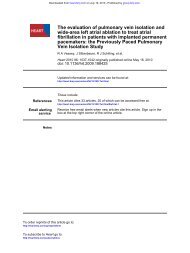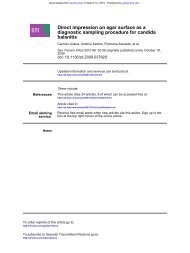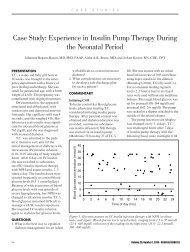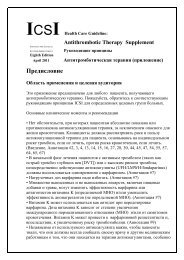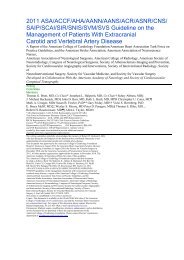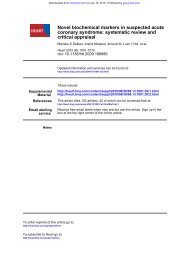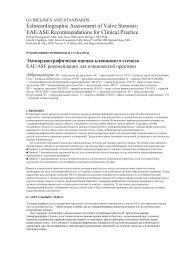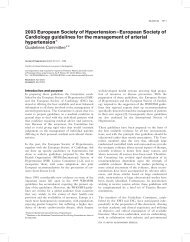echocardiography: basic principles Two dimensional speckle tracking
echocardiography: basic principles Two dimensional speckle tracking
echocardiography: basic principles Two dimensional speckle tracking
You also want an ePaper? Increase the reach of your titles
YUMPU automatically turns print PDFs into web optimized ePapers that Google loves.
Education in Heart<br />
1 AKH Linz, Department of<br />
Internal Medicine I - Cardiology,<br />
Krankenhausstrasse, Austria<br />
2 Department of Cardiology,<br />
Medical University of Vienna,<br />
Internal Medicine II, AKH,<br />
Waehringerguertel, Vienna,<br />
Austria<br />
Correspondence to<br />
Professor Dr Thomas Binder,<br />
Department of Cardiology,<br />
Medical University of Vienna,<br />
Internal Medicine II, AKH,<br />
Waehringerguertel 18-20, 1090<br />
Vienna, Austria; thomas.<br />
binder@meduniwien.ac.at<br />
Downloaded from<br />
heart.bmj.com on May 1, 2010 - Published by group.bmj.com<br />
NON-INVASIVE IMAGING<br />
<strong>Two</strong> <strong>dimensional</strong> <strong>speckle</strong> <strong>tracking</strong><br />
<strong>echocardiography</strong>: <strong>basic</strong> <strong>principles</strong><br />
Hermann Blessberger, 1 Thomas Binder 2<br />
<strong>Two</strong> <strong>dimensional</strong> (2D) <strong>speckle</strong> <strong>tracking</strong> <strong>echocardiography</strong><br />
(STE) is a promising new imaging<br />
modality. Similar to tissue Doppler imaging (TDI),<br />
it permits offline calculation of myocardial velocities<br />
and deformation parameters such as strain and<br />
strain rate (SR). It is well accepted that these<br />
parameters provide important insights into systolic<br />
and diastolic function, ischaemia, myocardial<br />
mechanics and many other pathophysiological<br />
processes of the heart. So far, TDI has been the only<br />
echocardiographic methodology from which these<br />
parameters could be derived. However, TDI has<br />
many limitations. It is fairly complex to analyse<br />
and interpret, only modestly robust, and frame rate<br />
and, in particular, angle dependent. Assessment of<br />
deformation parameters by TDI is thus only<br />
feasible if the echo beam can be aligned to the<br />
vector of contraction in the respective myocardial<br />
segment. In contrast, STE uses a completely<br />
different algorithm to calculate deformation: by<br />
computing deformation from standard 2D grey<br />
scale images, it is possible to overcome many of the<br />
limitations of TDI. The clinical relevance of deformation<br />
parameters paired with an easy mode of<br />
assessment has sparked enormous interest within<br />
the echocardiographic community. This is also<br />
reflected by the increasing number of publications<br />
which focus on all aspects of STE and which test<br />
the potential clinical utility of this new modality.<br />
Some have already heralded STE as ‘the next<br />
revolution in <strong>echocardiography</strong>’. This review<br />
describes the <strong>basic</strong> <strong>principles</strong> of myocardial<br />
mechanics and strain/SR imaging which form<br />
a basis for the understanding of STE. It explains<br />
how <strong>speckle</strong> <strong>tracking</strong> works, its advantages to<br />
tissue Doppler imaging, and its limitations.<br />
BACKGROUND<br />
Deformation parametersdstrain and strain rate<br />
Strain is a dimensionless quantity of myocardial<br />
deformation. The so-called Langrangian strain (e) is<br />
mathematically defined as the change of myocardial<br />
fibre length during stress at end-systole<br />
compared to its original length in a relaxed state at<br />
end-diastole¼(l-l0)/l0 (figure 1). 1 Strain is usually<br />
expressed in per cent (%). The change of strain per<br />
unit of time is referred to as strain rate (SR).<br />
Negative strain indicates fibre shortening or<br />
myocardial thinning, whereas a positive value<br />
describes lengthening or thickening.<br />
As SR (1/s) is the spatial derivative of tissue<br />
velocity (mm/s), and strain (%) is the temporal<br />
integral of SR, all of these three parameters are<br />
1 2<br />
mathematically linked to each other (figure 2).<br />
Basically, strain measures the magnitude of<br />
myocardial fibre contraction and relaxation. In<br />
contrast to TDI, it only reflects active contraction<br />
since the STE derived deformation parameters are not<br />
influenced by passive traction of scar tissue<br />
by adjacent vital myocardium (tethering effect) or<br />
cardiac translation. 3 Since contraction is three<br />
<strong>dimensional</strong> and myocardial fibres are oriented differently<br />
throughout the myocardial layers, deformation<br />
can also be described with respect to the different<br />
directional components of myocardial contraction. To<br />
truly understand deformation it is therefore essential<br />
to consider myocardial mechanics.<br />
Basics of myocardial mechanics<br />
The sophisticated myocardial fibre orientation of<br />
the left ventricular (LV) wall provides an equal<br />
distribution of regional stress and strains. 4 In<br />
healthy subjects, the left ventricle undergoes<br />
a twisting motion which leads to a decrease in the<br />
radial and longitudinal length of the LV cavity.<br />
During isovolumetric contraction the apex initially<br />
performs a clockwise rotation. During the ejection<br />
phase the apex then rotates counterclockwise while<br />
the base rotates clockwise when viewed from the<br />
apex. 5 In diastole relaxation of myocardial fibres<br />
and subsequent recoiling (clockwise apical rotation)<br />
contributes to active suction. 5 Thus, the contraction<br />
of the heart is similar to the winding (and<br />
unwinding) of a towel. From a mathematical point<br />
of view several parameters of myocardial mechanics<br />
can be described (figure 3):<br />
< Rotation (degrees)¼angular displacement of<br />
a myocardial segment in short axis view around<br />
the LV longitudinal axis measured in a single<br />
plane.<br />
< Twist or torsion (degrees) which is the net<br />
difference between apical and basal rotation<br />
(calculated from two short axis cross-sectional<br />
planes of the LV). 67<br />
< Torsional gradient (degrees/cm) which is defined<br />
as twist/torsion normalised to ventricular length<br />
from base to apex and accounts for the fact that<br />
a longer ventricle has a larger twist angle. 8<br />
LV twist can be quantified in short axis views by<br />
measuring both apical and basal rotation with the<br />
help of STE (figure 4). In addition, it is possible to<br />
calculate time intervals of contraction/relaxation<br />
with respect to torsion or rotation and therefore<br />
measure the speed of ventricular winding and<br />
unwinding. In particular, the speed of apical recoil<br />
716 Heart 2010;96:716e722. doi:10.1136/hrt.2007.141002


